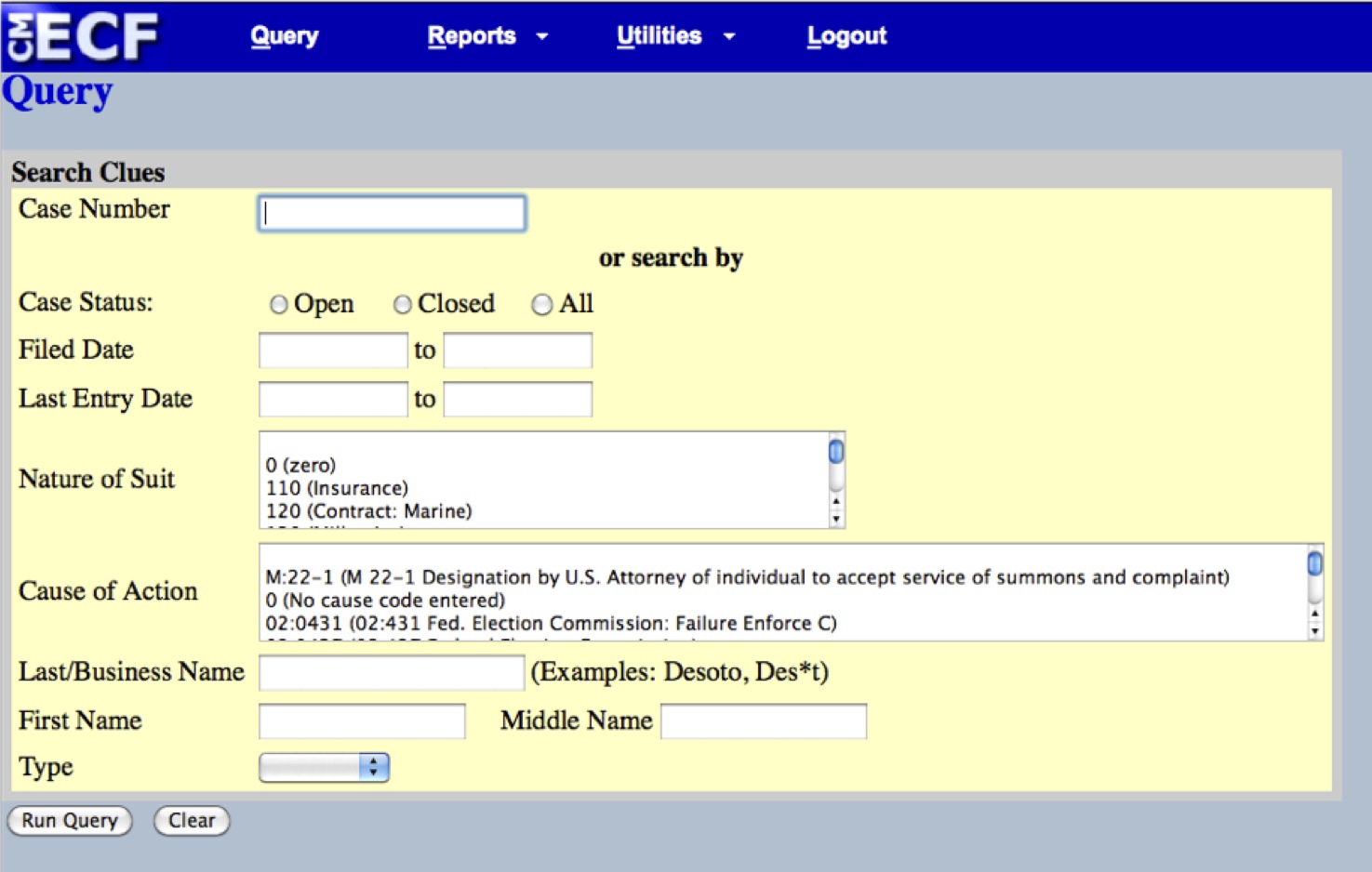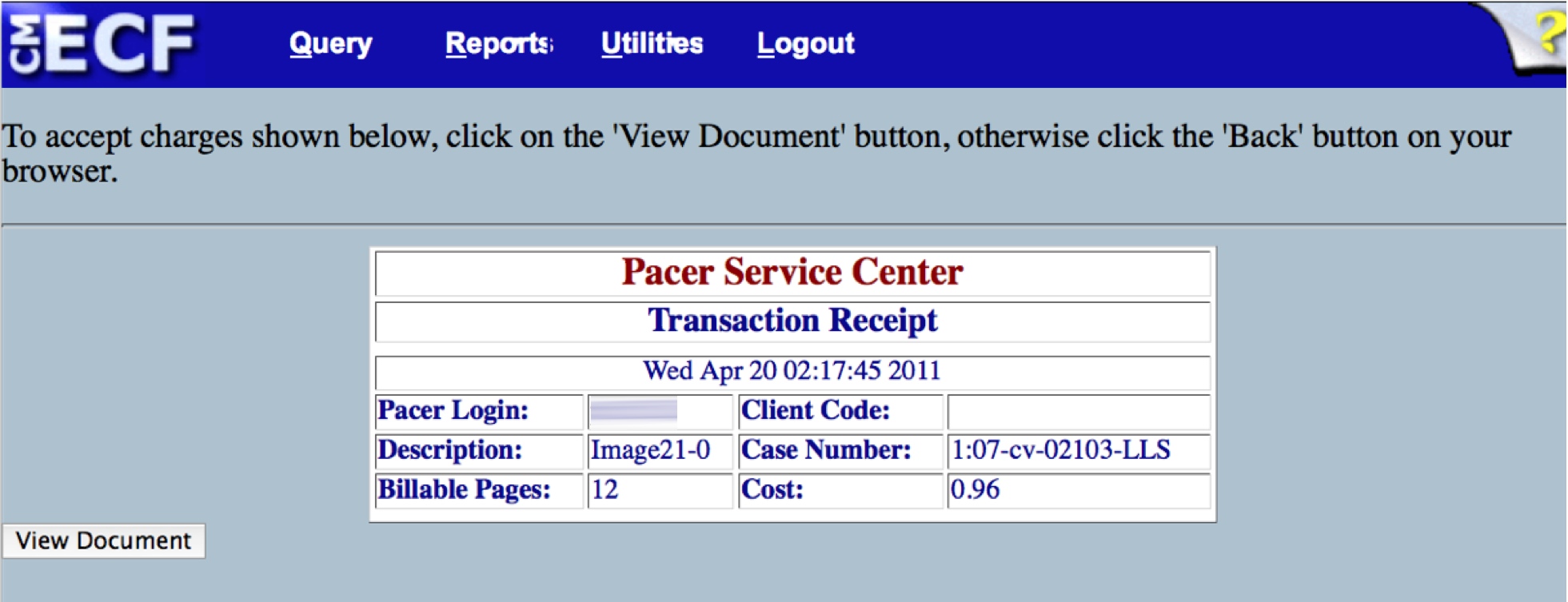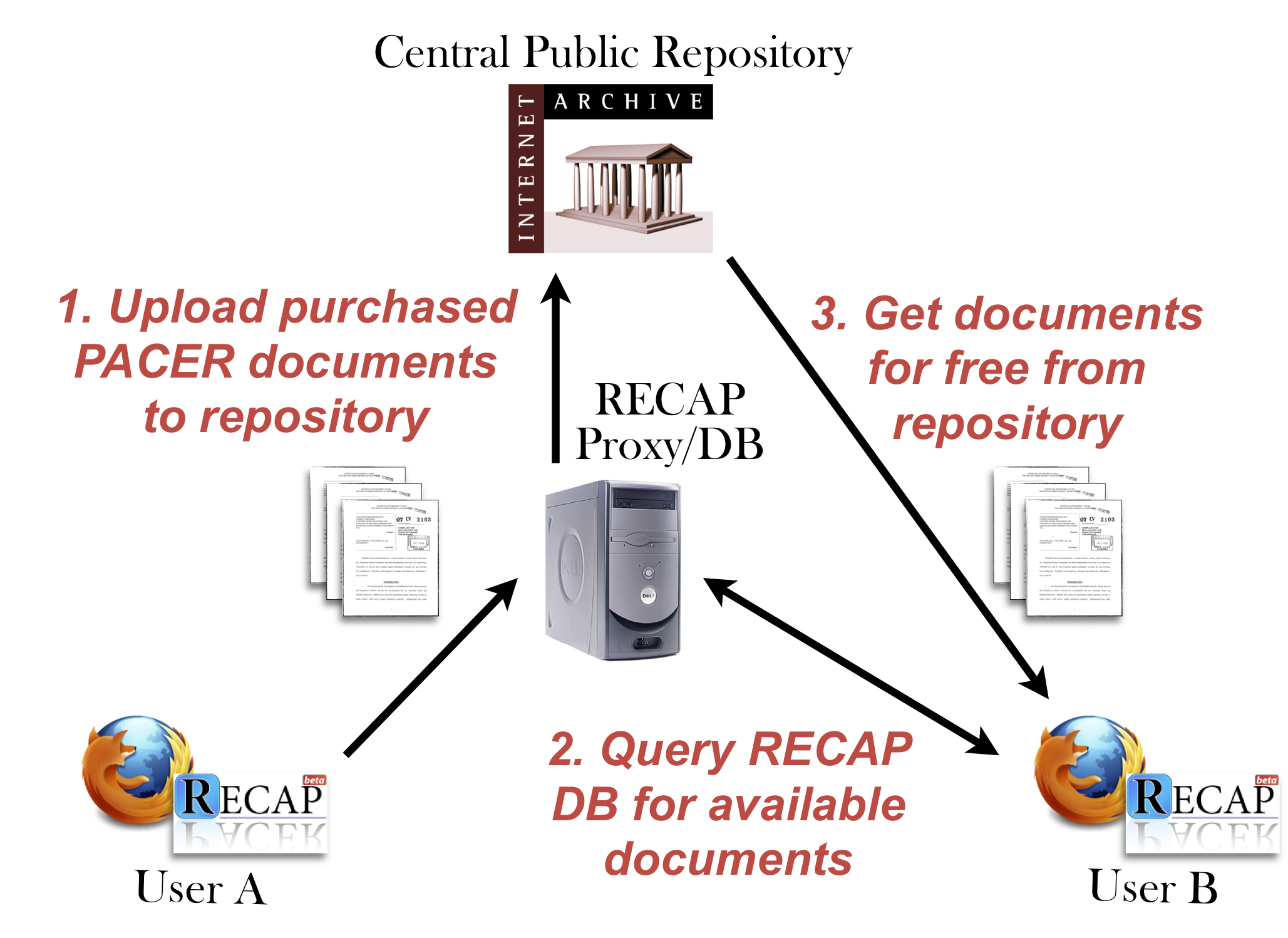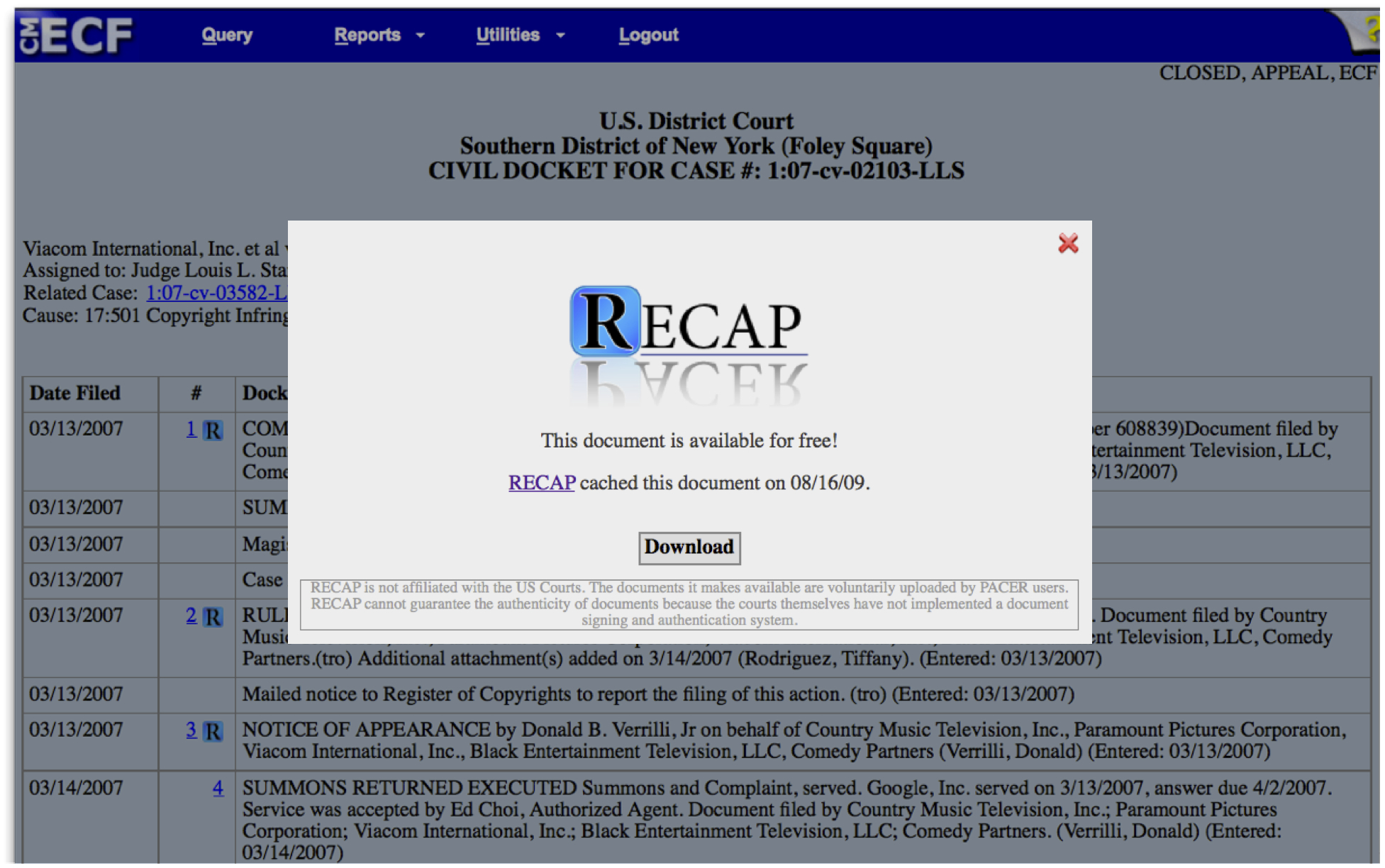XRDS Magazine recently ran an article by Steve Schultze and Harlan Yu
entitled Using Software to Liberate U.S. Case
Law. The article describes the
motivation behind RECAP, and outlines the state of public access to
electronic court records.
Using PACER is the only way for citizens to obtain electronic records
[…]
from the Courts. Ideally, the Courts would publish all of their
records online, in bulk, in order to allow any private party to index
and re-host all of the documents, or to build new innovative services
on top of the data. But while this would be relatively cheap for the
Courts to do, they haven’t done so, instead choosing to limit “open”
access.Since the first release, RECAP has gained thousands of users, and the
[…]
central repository contains more than 2.3 million documents across
400,000 federal cases. If you were to purchase these documents from
scratch from PACER, it would cost you nearly $1.5 million. And while
our collection still pales in comparison to the 500 million documents
purportedly in the PACER system, it contains many of the
most-frequently accessed documents the public is searching for.As with many issues, it all comes down to money. In the E-Government
Act of 2002, Congress authorized the Courts to prescribe reasonable
fees for PACER access, but “only to the extent necessary” to provide
the service. They sought to approve a fee structure “in which this
information is freely available to the greatest extent possible”.However, the Courts’ current fee structure collects significantly more
funds from users than the actual cost of running the PACER system.
Using Software to Liberate U.S. Case Law
By Harlan Yu and Stephen Schultze
“Ignorance of the law is no excuse.” This legal principle puts the
responsibility on us—the citizens—to know what the law says in order to
abide by it. This principle assumes that citizens will have open access
to the laws that our government prescribes so that we will have adequate
opportunity to learn our civic obligations. A complimentary legal
principle obligates the justice system to provide equal access to the
law for all citizens, without regard to social or economic status.
While these may seem like basic conditions in a democracy, equal and
open access to the law in the United States (U.S.) has been a
work-in-progress. In past generations, access meant not only equal
rights to petition the court and defend yourself, but also the ability
to sit and observe the government from the gallery of a legislative
chamber or a courtroom. It also meant obtaining copies of written
records that document these activities. Of course, for those who didn’t
have the time or money to physically visit the courthouse or buy
expensive compendiums of decisions, the law often remained opaque and
unknown. These limitations to access were consequences of the analog
format, which made obtaining vast amounts of information neither easy
nor cheap.
But as society embraces digital distribution of information over the
Internet, the potential for equal and open access to the law is no
longer limited by physical constraints. Digital distribution is
instantaneous, cheap, and will eventually reach all corners of our
society.
The U.S. Courts were among the first in the government to recognize this
enormous potential. They began building a system in the early 1990s
called PACER—Public Access to Court Electronic Records—that started out
as a dial-up system and eventually transitioned to a graphical Web
interface. The system provides access to all of the raw documents in
federal court proceedings since its inception. But while PACER has
without a doubt expanded public access to federal court information, the
government has yet to harness digital technologies in a way that
realizes the full potential for equal and open access that they present.
How PACER Limits Access
PACER makes hundreds of millions of court documents available online to
the public. Using the system to find relevant information, however, can
be quite a challenge.
The entire PACER system is made up of about 200 individual data
silos—one instance of the PACER software for each of the federal
district, bankruptcy, and circuit courts—and the system provides very
limited functionality to search across all of the silos. Within each
silo, it’s only possible to do a search over a few fields, rather than
over the full-text of all of the available documents—a stark contrast to
what’s possible on modern Web search engines. Indeed, because of PACER’s
walled-garden approach, search engines are unable to crawl its contents.
The interface also relies heavily on legal jargon, making it difficult
for citizens to figure our where and how to search (see Figure 1).

Figure 1. The PACER search interface for the Southern District of New
York.
But the biggest problem with PACER by far is its pay-for-access model.
The Courts charge PACER users a fee of eight cents per page to access
its records (see Figure 2). This means that, when looking for documents,
searches will cost eight cents for every 4320 bytes of results—one
“page” of information according to PACER’s policy. Getting a docket that
lists all the documents in a case can cost the user a couple of dollars.
To download a specific document, say a 30-page PDF brief, the user would
be charged another $2.40 for the privilege. While each individual
charge may seem small, the cost incurred by using PACER for any
substantial purpose racks up very quickly. Repeated searching using the
limited interface can become particularly costly.

Figure 2. PACER receipt page for purchasing a court document.
Even at many of our nation’s top law schools, access to the primary
legal documents in PACER is limited for fear that their libraries’ PACER
bills will spiral out of control 1. Academics who want to study
large quantities of court documents are effectively shut out. Also
affected are journalists, non-profit groups, and other interested
citizens, whose limited budgets make paying for PACER access an unfair
burden. From the Court’s own statistics, nearly half of all PACER users
are attorneys who practice in the federal courts, which indicate that
PACER is not adequately serving the general public 2. The
pay-for-access model bears much of the blame.
Furthermore, the Courts do not provide any consistent machine-readable
way to index or track cases, even though all of this information is
gathered electronically and stored in relational databases. Anyone
seeking to comprehensively analyze case materials faces an uphill battle
of reconstructing the original record.
Using PACER is the only way for citizens to obtain electronic records
from the Courts. Ideally, the Courts would publish all of their records
online, in bulk, in order to allow any private party to index and
re-host all of the documents, or to build new innovative services on top
of the data. But while this would be relatively cheap for the Courts to
do, they haven’t done so. The reason will be explained in a later
section.
Liberating Court Records with RECAP
Because everything in PACER is part of the public record, users can
legally share their document purchases freely once they have been
legitimately acquired. Recognizing this possibility, we created a
Firefox extension called RECAP—to “turn PACER around” 3. RECAP
crowdsources the purchase of the PACER repository by helping users to
automatically share their purchases. The extension provides two primary
functions (see Figure 3).

Figure 3. Diagram of the RECAP document sharing model.
First, whenever a user purchases a document from PACER, the extension
will automatically in the background upload a copy of the document to
our central repository hosted by the Internet Archive, where it will be
indexed and saved. This effectively liberates that document from behind
the PACER paywall.
Second, RECAP helps PACER users save money by notifying them whenever
documents are available from the shared central repository. Whenever a
user pulls up a docket listing, the extension will query the central
RECAP database to check whether any of the listed documents are already
in our repository. If so, the extension will inject a small RECAP link
next to the PACER link to indicate that the user can download the
document for free from our repository, rather than buying it again from
PACER (see Figure 4).

Figure 4. Accessing documents from RECAP while using PACER.
When RECAP was released in August 2009, the Courts reacted somewhat
impulsively. They issued warnings to PACER users that RECAP might be
dangerous to use because it was “open source” software, but ultimately
they had no legal recourse against a tool that simply helped citizens to
exercise their right to share public records.
Since the first release, RECAP has gained thousands of users, and the
central repository contains more than 2.3 million documents across
400,000 federal cases. If you were to purchase these documents from
scratch from PACER, it would cost you nearly $1.5 million. And while
our collection still pales in comparison to the 500 million documents
purportedly in the PACER system, it contains many of the most-frequently
accessed documents that the public is searching for.
Why the Courts Resist Open Access
With PACER’s many limitations, it’s not difficult to imagine how one
might build a better, more intuitive online interface for access to
court records. Indeed, a group of Princeton undergraduates spent a
semester building a beautiful front-end on top of our repository, called
the RECAP Archive, available at archive.recapthelaw.org. Access to case
law would be much improved if all of PACER’s records were available
within the RECAP Archive. But it’s unlikely that the Courts will
voluntarily drop the PACER paywall any time soon.
(Update, 2016-11-04: archive.recapthelaw.org has been replaced with a new version here.)
As with many issues, it all comes down to the money. In the E-Government
Act of 2002, Congress authorized the Courts to prescribe reasonable fees
for PACER access, but “only to the extent necessary” to provide the
service. They sought to approve a fee structure “in which this
information is freely available to the greatest extent possible” 4.
However, the Courts’ current fee structure collects significantly more
funds from users than the actual cost of running the PACER system. We
examined the Courts’ budget documents from the past few years, and we
discovered that the Courts claim PACER expenses of roughly $25 million
per year. But in 2010, PACER users paid about $90 million in fees to
access the system 5. The extra funds are deposited into a fund for
IT projects for the Courts. This fund is used to purchase a diversity of
unrelated things for the Courts, like flat screen monitors in courtrooms
and state-of-the-art AV systems. While we support the Courts’ adoption
of these modern technologies, it shouldn’t come at the direct expense of
legally mandated open access to court records.
Indeed, the reported figure of $25 million per year to run PACER either
wildly over-estimates the actual cost, or is a reflection of a system
that’s built horribly inefficiently, perhaps both. The cost of making a
few hundred terabytes of data available on the Web is not low, but in an
era of abundant and ever-cheaper cloud storage and hosting services, it
also shouldn’t be anywhere near the claimed costs. The Courts’ highly
distributed infrastructure—each courthouse manages its own servers and
private network links—may have made sense two decades ago, but today it
only perpetuates higher than necessary costs and barriers to citizen
access.
The Decline of Practical Obscurity
One significant challenge in opening up federal court records is the
concern over personal privacy. Many of life’s dramas play themselves out
in our public courtrooms. Consider in cases concerning divorce, domestic
abuse and bankruptcy. Many intimate private details are revealed in
these proceedings and are part of public case records.
Before electronic records, the Courts relied on the notion of “practical
obscurity” to protect sensitive information. That is, because these
documents were only available by physically traveling to the courthouse
to obtain the paper copy, the sensitive data contained therein—while
public—were in practice obscure enough that very few people, if anyone,
would ever see them.
Only in 2007 did the Courts define formal procedural rules that required
attorneys to redact certain sensitive information from court filings.
But not only were the Courts not very diligent at enforcing their own
rule, older documents which were subsequently scanned and made available
electronically contain substantial amounts of sensitive information,
such as Social Security numbers and names of minor children.
A preliminary audit conducted by Carl Malamud found that more than 1,500
documents in PACER, out of a sample of 2.7 million documents, contain
unredacted social security numbers and other sensitive information
6. Research by Timothy Lee, our fellow RECAP co-creator and computer
science student at Princeton, studied the rate of “failed redactions” in
PACER, where authors simply drew a black box over the sensitive
information in the PDF, leaving the sensitive information in the
underlying file. He estimated that tens of thousands of files with
failed redactions exist in PACER today 7.
PACER’s paywall attempts to extend practical obscurity, at least
temporarily, to the digital realm, since it prevents the documents
behind it from being indexed by major search engines. But over time,
these documents will ultimately make their way into wider distribution,
whether through RECAP or other means. Large data brokers already
regularly mine PACER for personal data. The resulting decline in
practical obscurity will ultimately force the Courts to deal more
directly with the privacy problem.
This may mean that documents will need to be more heavily redacted
before they are filed publicly, or in some cases, entire documents will
need to be sealed from public view. It is not always easy to align
privacy and open access, but what’s clear is that the Courts ought to
make more explicit determinations about which data are sensitive and
which are not, rather than relying simply on the hope that certain
records won’t often be accessed.
Somewhat counter-intuitively, more openness can help lead to more
privacy if citizens become aware of what information is contained in
public records and more proactively choose what to include and when to
petition for redaction or sealing. A more accessible corpus also
provides opportunities for researchers to devise new methods to protect
personal privacy while enhancing the accessibility of the law.
The Courts can benefit from improved technology and smart computer
scientists in this task. In our initial research in this area, we
already identified several ways for the Courts to more automatically
identify and redact sensitive information. Using text analysis and
machine learning techniques, and what we already know about the
prevalence of sensitive information in the PACER corpus, we can try to
prioritize documents for human review, starting with the documents that
are most likely to contain sensitive information.
Conclusion
The PACER paywall is a significant barrier to public participation in
the U.S. justice system. Online access to court records, through
innovative third-party services, has the potential to serve as the
spectators’ gallery of the 21st century. But without free and open
access to the underlying data, it is nearly impossible for developers to
build new, useful services for citizens.
Digital technologies present our Courts with a key opportunity to
advance our Founders’ vision of forming a more perfect Union, with equal
justice under the law. Opening up free access to all electronic court
records would mark a significant step in our collective journey.
Biographies
Harlan Yu is a Ph.D. candidate in Computer Science at Princeton
University, affiliated with the Center for Information Technology Policy
(CITP). His primary research interests include computer security,
privacy and open government. He received his BS from UC Berkeley and his
MA from Princeton.
Stephen Schultze is the Associate Director of the Center for Information
Technology Policy at Princeton University. His work at CITP includes
internet privacy, computer security, government transparency, and
telecommunications policy. He holds degrees from Calvin College and MIT.
Disclaimer
© ACM, 2011. This is the author’s version of the work. It is posted
here by permission of ACM for your personal use. Not for redistribution.
The definitive version was published in ACM XRDS, Vol. 18, Issue 2,
Winter 2011. http://doi.acm.org/10.1145/2043236.2043244
Source link



